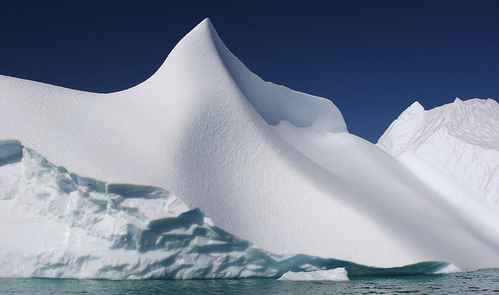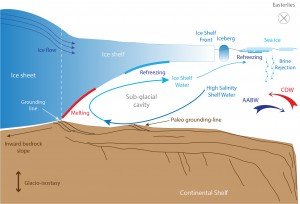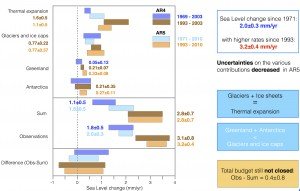The Antarctic sea ice cover have continued to increase despite climate change effects. A trend opposite to what is observed in the Arctic: according to the last IPCC AR5, over the last two decades, the Greenland ice sheet has been losing mass, glaciers have continued to shrink and Arctic sea ice has continued to decrease in extent. Nevertheless, Antarctic ice sheet is at risk due to climate change: it doesn’t lose its mass because of surface melting, like Greenland, but by the calving of icebergs at the front of marine terminating glaciers or at the front of the ice shelves. Recently, scientists discovered another additional threats to the future of Greenland and Antarctica, that is the ocean-induced basal melting of the ice sheets. This process could cause the fast disappearing of the West Antarctic Ice Sheet and the fast retreat of the Greenland margins. The complete melting ice of West Antarctica would represent a global mean sea level rise of about six meters.
Florence Colleoni* and Laura De Santis**
* Fondazione CMCC, Bologna
**OGS – Istituto Nazionale di Oceanografia e di Geofisica Sperimentale, Trieste.
Over the last decade, the satellites observed an expansion of the sea ice cover around Antarctica, a trend opposite to what is observed in the Arctic Ocean. Several mechanisms have been proposed to explain this phenomenon, such as the strengthening of the westerlies due to an anomalous persistence in the positive phase of the Southern Annular Mode (SAM) inducing a cooling over Antarctica and thus fostering the sea ice production [1], a negative sea ice/ocean feedback with a decrease in the ocean heat flux available for sea ice melting [2], and at last, the melting of the Antarctic ice shelves due to the effect of the intrusion of the warm Circumpolar Deep Waters [3]. The freshwater melting from the ice shelves mixes with the High Salinity Shelf Water entering the cavities to form the Ice Shelf Water (see figure 1). The Ice Shelf Water is exported out of the cavities, on the continental shelf and because of its low salinity and cold temperature, part of it refreezes under the sea ice and contributes to the expansion of the sea ice cover around Antarctica. The remaining part contributes to the Antarctic Deep Water formation.
This process is also observed in the Fjords around Greenland, where the marine terminating glaciers are also subject to melting due to the interactions with the nearby ocean waters [4].
Little is known about the physical processes occurring at the ice – ocean interface and until recently only few observations were available to constrain the magnitude of the basal melting occurring under the ice shelves and the marine glaciers.
Figure 1: Ice shelf interactions with ocean processes under the cavities. Note that the continental margin sediment layers deposit resulting from ice dynamics have been represented. AABW: Antarctica Bottom Water (cold and dense waters); CDW: Circumpolar Deep Water (warm waters).
Why focusing on those climatic processes?
The current melting of the cryosphere, and especially the mountain glaciers and the polar ice sheets contributes to the ongoing and projected sea level changes, but also to changes of the regional climate caused by the increase in albedo and changes in topography. Assessing current and future sea level changes has become a critical aspect of the assessment of the socio-economic impacts of climate change [5]. In fact, the populations leaving in low-lying coastal areas are directly threaten by sea level changes. In some areas, sea level changes will trigger climatic migrations, as for example in the small Pacific Islands that are already severely impacted by current sea level rise occurring in the West Pacific [6],[7].
In 2007, the IPCC report AR4 [8] highlighted the gap between satellite observations and estimates of the individual contributions to sea level change over the last decades (see figure 2). While the satellite altimetry indicated a global mean sea level rise of about 3.1 ± 0.8 mm/yr over the period 1993-2003 (1.8 ± 0.5 mm/yr for the period 1969-2003), the sum of the individual estimates of the various contributors to sea level yielded 2.8 ± 0.7 mm/yr over the period 1993-2003 (1.1 ± 0.5 mm/yr for the period 1969 -2003). Resources have been invested in the polar research to better constrain the contribution of Greenland and Antarctica and close the gap. In the last IPCC report AR5 [9], those estimates improved, and the actual numbers indicate a contribution of 0.33 ± 0.08 mm/yr for the Greenland ice sheet over the period 1993-2010 and a contribution of 0.27 ± 0.11 mm/yr for Antarctica. However, the gap between satellites observations and the sum of the individual contributions remains and amounts to about 0.4 ± 0.8 mm/yr.
The expansion of the sea ice cover in the Southern Ocean induced by the melting of the Antarctic ice shelves has not been precisely quantified in the AR5. This process, that satellites are starting to capture, is the direct evidence that Antarctica is significantly contributing to the ongoing sea level changes, while in the IPCC report AR4, its contribution has been estimated close to 0 mm/yr. The Antarctic ice sheet does not lose its mass (or only a few) because of surface melting, like Greenland, but by the calving of icebergs at the front of the marine terminating glaciers or at the front of the ice shelves. Based on the increasing number of observations, the melting of the ice shelves occurring under the cavities is now defined as an additional threat to the future evolution of Greenland and Antarctica [10].
Figure 2: Individual contributions to global mean sea level change: comparison between IPCC AR4 and IPCC AR5 estimates.
Why is it crucial to investigate the ocean-induced basal melting of the ice sheets?
Numerical models show that this process could cause the fast disintegration of the West Antarctic Ice Sheet (WAIS), whose base is located below sea level, and the fast retreat of the Greenland margins. In the case of Antarctica, if the topography under the ice sheet has a slope directed inward, and not toward the ocean, the collapse might occur faster (see figure 2). This mechanism has been defined as the marine ice sheet instability. As documented by past marine sediment records collected in the Ross Sea (West Antarctica, Pacific sector), the collapse of the WAIS already happened frequently over the past five million years [11],[12]. However, the reasons of these frequent collapses are not fully understood. The relative role of ocean warming compared to increase in atmospheric temperature in the framework of past climates warmer than today is still under investigation. This aspect is particularly important when current global temperatures are projected to rise in both ocean and atmosphere in the next decades. The complete decay of WAIS would represent a global mean sea level rise of about 6 meters, equivalent to the volume of the Greenland ice sheet.
***
The scientific community on polar research met and and discussed these topics at the workshop “Ocean – Ice interactions workshop – bridging observations and models”, organized by CMCC Foundation on October 17-18, 2016, in Bologna. Researchers from various institutes (CMCC, OGS, INGV, CNR, ENEA) and from different Italian universities (Trieste, Venezia, Napoli, Urbino) explored the state-of-the-art expertise developed by the Italian polar community over the last decades with a focus on the interactions between ocean and ice sheets. The meeting aimed at putting together numerical models developed by some of the participating institutions and the numerous observations collected in polar areas during the past decades by the Italian research community. The main overarching goal was to reconstruct the past and future climates of the polar areas, in particular in the framework of the ice-ocean interactions, including the dynamics of the climate system, ice dynamics, isostasy and the evolution of the continental margins.
The ocean-ice interactions workshop organized at CMCC followed the annual conference of PNRA (Programma Nazionale di Ricerche in Antartide), that took place in Rome in November 2015 (more information here).
References:
1. Goosse, H., Lefebvre, W., de Montety, A., Crespin, E., & Orsi, A. H. (2009). Consistent past half-century trends in the atmosphere, the sea ice and the ocean at high southern latitudes. Climate Dynamics, 33(7-8), 999-1016.
2. Zhang, J. (2007). Increasing Antarctic sea ice under warming atmospheric and oceanic conditions. Journal of Climate, 20(11), 2515-2529.
3. Bintanja, R., Van Oldenborgh, G. J., Drijfhout, S. S., Wouters, B., & Katsman, C. A. (2013). Important role for ocean warming and increased ice-shelf melt in Antarctic sea-ice expansion. Nature Geoscience, 6(5), 376-379.
4. Straneo, F., & Heimbach, P. (2013). North Atlantic warming and the retreat of Greenland’s outlet glaciers. Nature, 504(7478), 36-43.
5. Lenton, T. M., Held, H., Kriegler, E., Hall, J. W., Lucht, W., Rahmstorf, S., & Schellnhuber, H. J. (2008). Tipping elements in the Earth’s climate system. Proceedings of the national Academy of Sciences, 105(6), 1786-1793.
6. Mimura, N. (1999). Vulnerability of island countries in the South Pacific to sea level rise and climate change. Climate research, 12(2-3), 137-143.
7. Mortreux, C., & Barnett, J. (2009). Climate change, migration and adaptation in Funafuti, Tuvalu. Global Environmental Change, 19(1), 105-112.
8. Solomon, S., Qin, D., Manning, M., Chen, Z., Marquis, M., Averyt, K. B., … & Miller, H. L. (2007). IPCC fourth assessment report (AR4). Retrieved, 4(13), 2011.
9. Stocker, T. F., Qin, D., Plattner, G. K., Tignor, M., Allen, S. K., Boschung, J., … & Midgley, P. M. (2013). Climate change 2013: the physical science basis. Intergovernmental panel on climate change, working group I Contribution to the IPCC fifth assessment report (AR5). New York.
10. Rignot, E., Jacobs, S., Mouginot, J., & Scheuchl, B. (2013). Ice-shelf melting around Antarctica. Science, 341(6143), 266-270.
11. Naish, T., Powell, R., Levy, R., Wilson, G., Scherer, R., Talarico, F., … & Carter, L. (2009). Obliquity-paced Pliocene West Antarctic ice sheet oscillations. Nature, 458(7236), 322-328.
12. Pollard, D., & DeConto, R. M. (2009). Modelling West Antarctic ice sheet growth and collapse through the past five million years. Nature, 458(7236), 329-332.






